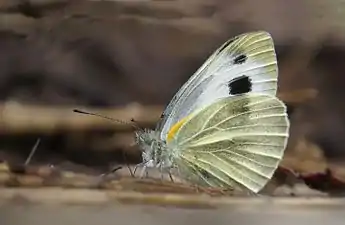| Indian cabbage white | |
|---|---|
 | |
| Dorsal view | |
 | |
| Ventral view | |
| Scientific classification | |
| Domain: | Eukaryota |
| Kingdom: | Animalia |
| Phylum: | Arthropoda |
| Class: | Insecta |
| Order: | Lepidoptera |
| Family: | Pieridae |
| Genus: | Pieris |
| Species: | P. canidia |
| Binomial name | |
| Pieris canidia (Sparrman, 1768) | |
Pieris canidia, the Indian cabbage white,[1][2] is a butterfly in the family Pieridae found in India, Nepal and Indochina.[1][2] Pieris rapae is one of the most closely related species in the Pieridae.
Description
The male is white to pale cream on its upperside. The base of the forewing, the basal portion of the costa, and the base and upper margin of the cell have a scattering of black scales. It is black from the apex to about the middle of the terminal margin. On the latter the black extends for a very short distance triangularly along the veins. There is a round black spot in interspace 3. The hindwing has a subcostal black spot as in Pieris rapae but is generally larger and more conspicuous, and a series of four or five terminal black spots that vary in size at the apices of the veins.[3]
Underside: the forewing is white; cell and costa are lightly irrorated (speckled) with black scales; apex is somewhat broadly tinged with ochraceous yellow. Interspaces 1, 3 and 5 have conspicuous subquadrate black spots; the spot in interspace 1 sometimes extends out of interspace 1. That in interspace 5 is ill-defined. Hindwing: from pale, almost white, to dark ochraceous, thickly irrorated all over (with the exception of a longitudinal streak in the cell, and in the darker specimens similar longitudinal streaks in the interspaces) with black scales; costa above vein 8 are chrome yellow. Antennae are black with minute white specks; the long hairs on the head and thorax are greenish grey; the abdomen is black. Beneath, the head, thorax and abdomen are white.[3]
The female is similar to the male on the underside, but the scattering of black scales is more prominent; the black on the apex and termen of the forewing and the black spots on the termen of the hindwing are broader and more extended inwards; on the forewing there is an additional spot in interspace 1, and both this and the spot in interspace 3 in many specimens are connected by a line of black scales along the veins to the outer black border; also the spot in interspace 1 often extends across vein 1 into the interspace below.[3][4]
It has a wingspan of 42–60 mm.
Distribution
It lives in sub-Himalayan India and Pakistan from Chitral, Kashmir to Sikkim and Bhutan, from 2,000 to 11,000 ft (610 to 3,350 m) elevation; the hills of southern India; Assam; Upper Myanmar: the Shan States; extending to China.[3]
See also
Notes
- 1 2 Varshney, R.K.; Smetacek, Peter (2015). A Synoptic Catalogue of the Butterflies of India. New Delhi: Butterfly Research Centre, Bhimtal & Indinov Publishing, New Delhi. p. 73. doi:10.13140/RG.2.1.3966.2164. ISBN 978-81-929826-4-9.
- 1 2 Savela, Markku. "Pieris canidia (Linnaeus, 1768)". Lepidoptera and Some Other Life Forms. Retrieved July 3, 2018.
- 1 2 3 4
 One or more of the preceding sentences incorporates text from this source, which is in the public domain: Bingham, C.T. (1907). The Fauna of British India, Including Ceylon and Burma. Vol. II (1st ed.). London: Taylor and Francis, Ltd. pp. 172–173.
One or more of the preceding sentences incorporates text from this source, which is in the public domain: Bingham, C.T. (1907). The Fauna of British India, Including Ceylon and Burma. Vol. II (1st ed.). London: Taylor and Francis, Ltd. pp. 172–173. - ↑ Moore, Frederic (1903–1905). Lepidoptera Indica. Vol. VI. London: Lovell Reeve and Co. pp. 133–136.
References
- Evans, W.H. (1932). The Identification of Indian Butterflies (2nd ed.). Mumbai, India: Bombay Natural History Society.
- Gaonkar, Harish (1996). Butterflies of the Western Ghats, India (including Sri Lanka) - A Biodiversity Assessment of a Threatened Mountain System. Bangalore, India: Centre for Ecological Sciences.
- Gay, Thomas; Kehimkar, Isaac David; Punetha, Jagdish Chandra (1992). Common Butterflies of India. Nature Guides. Bombay, India: World Wide Fund for Nature-India by Oxford University Press. ISBN 978-0195631647.
- Kunte, Krushnamegh (2000). Butterflies of Peninsular India. India, A Lifescape. Hyderabad, India: Universities Press. ISBN 978-8173713545.
- Wynter-Blyth, Mark Alexander (1957). Butterflies of the Indian Region. Bombay, India: Bombay Natural History Society. ISBN 978-8170192329.